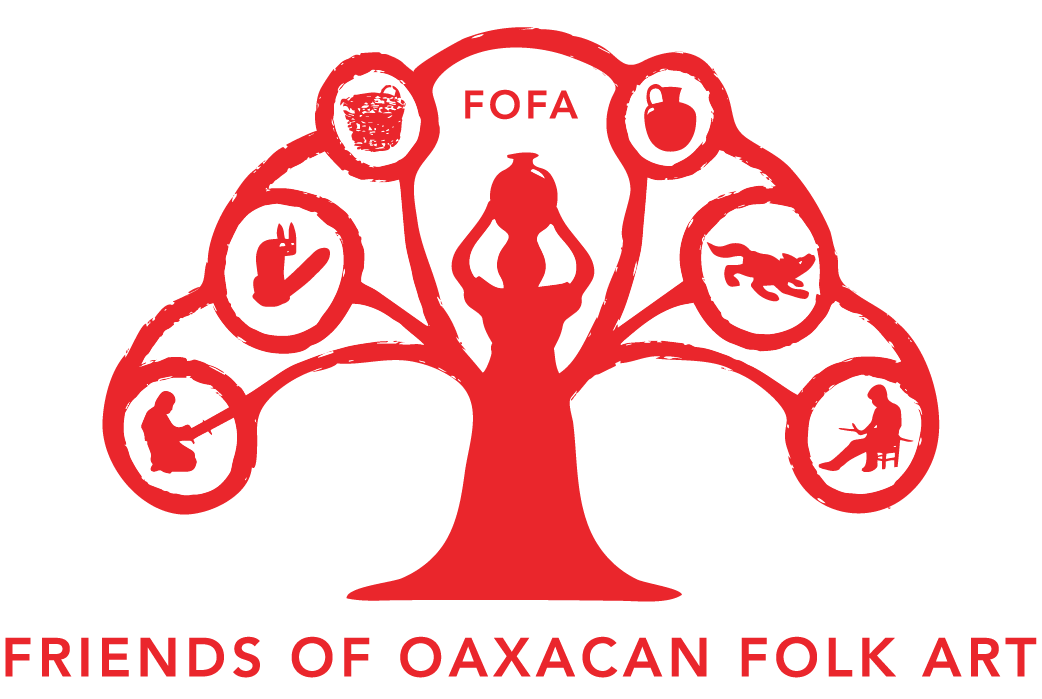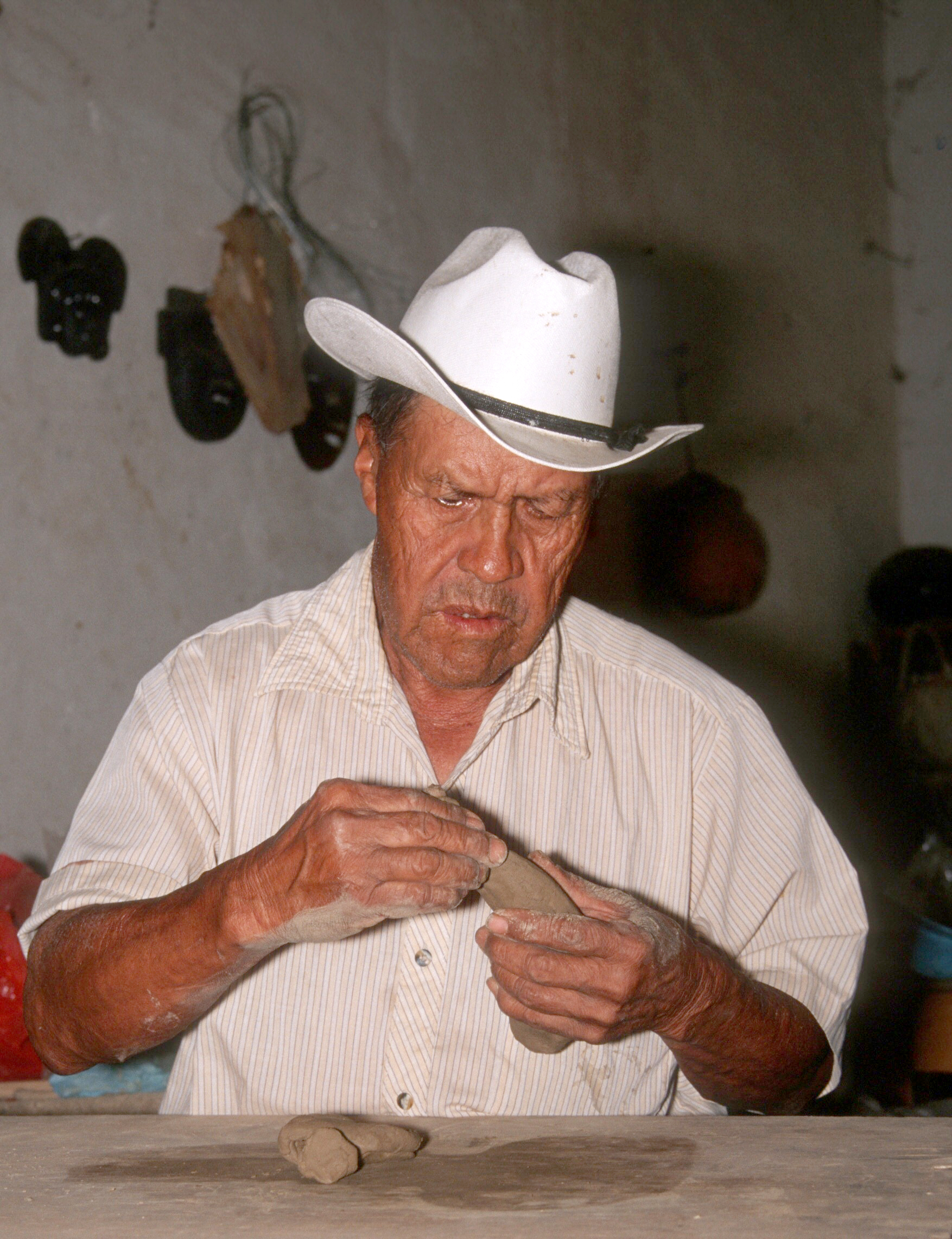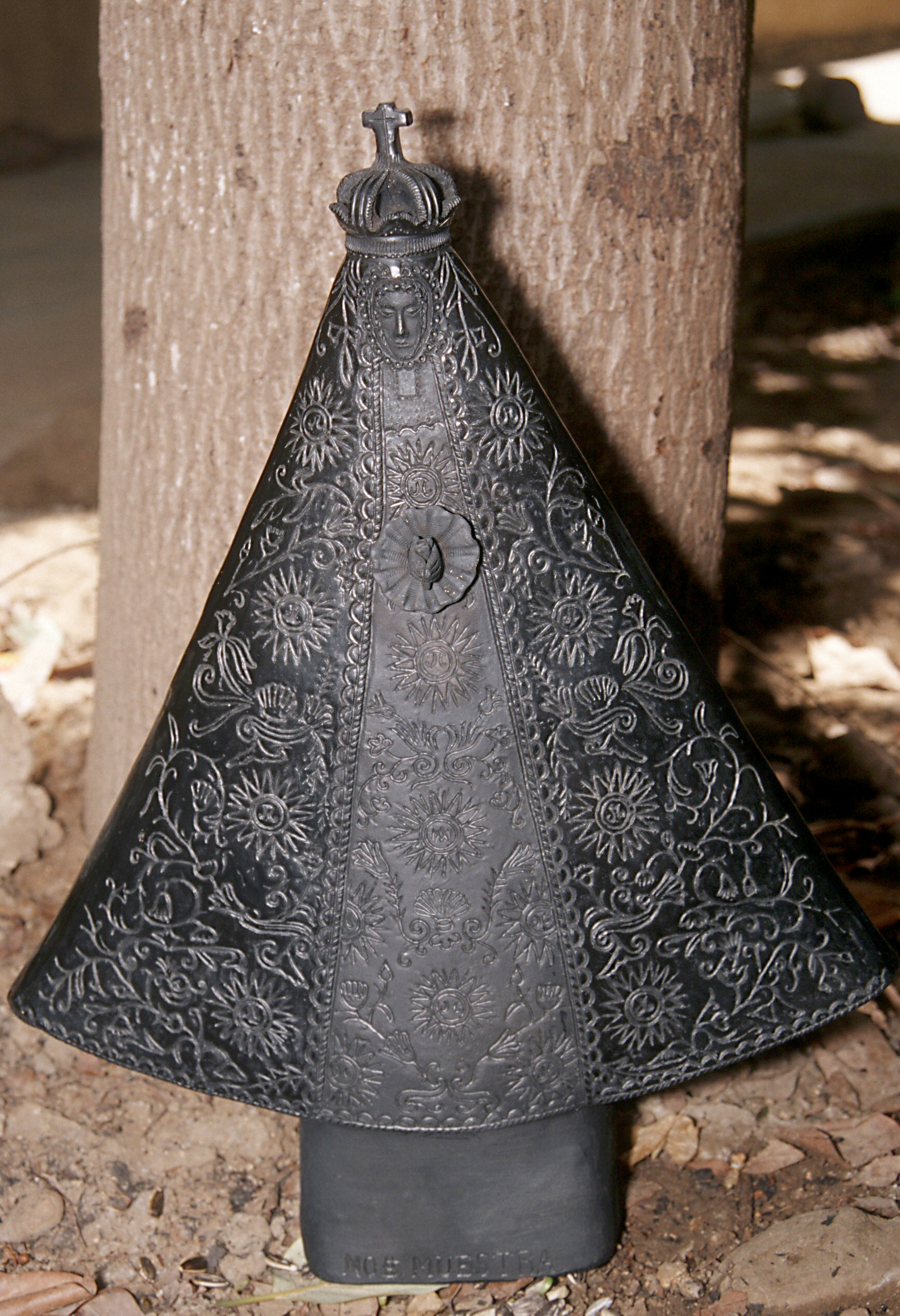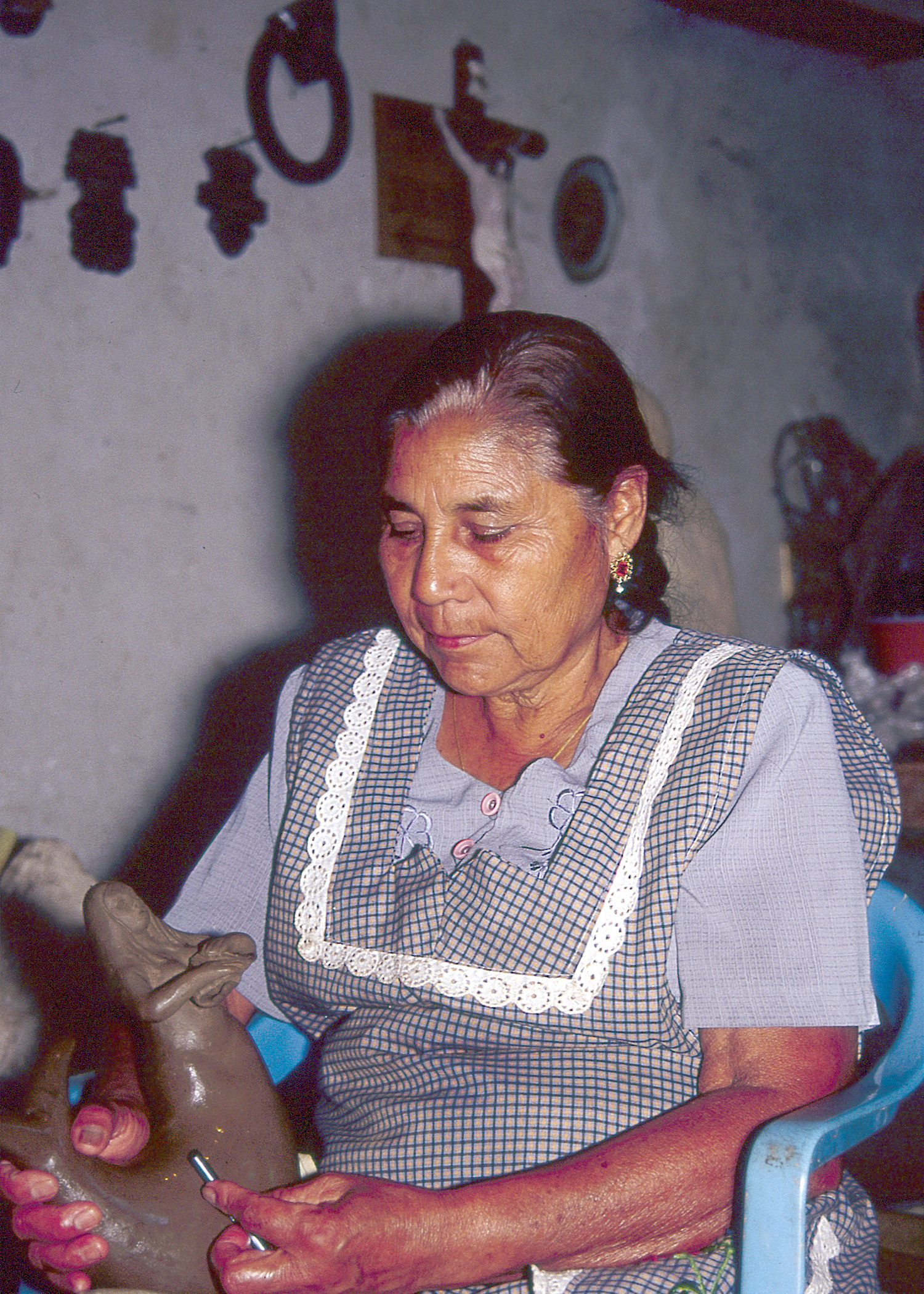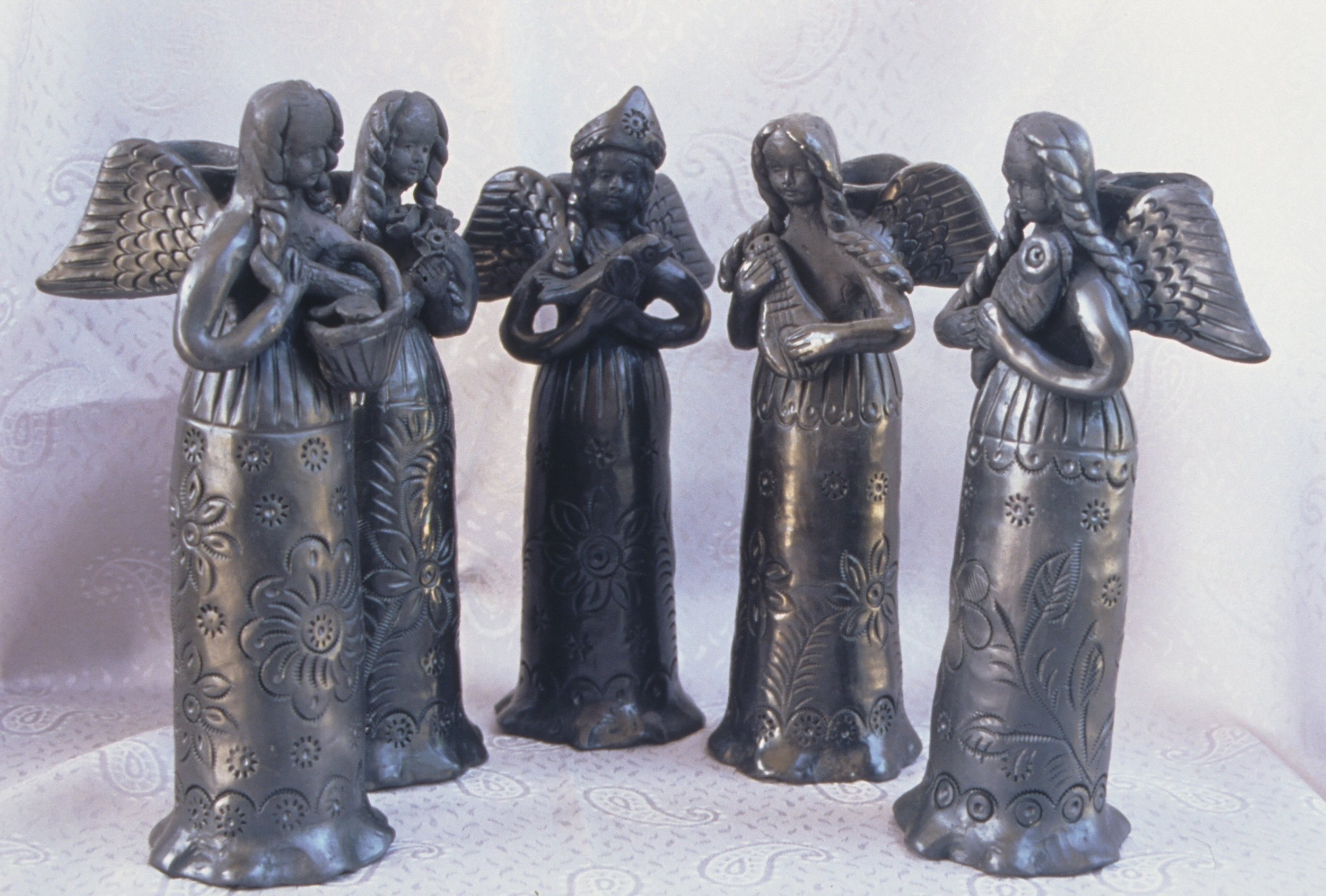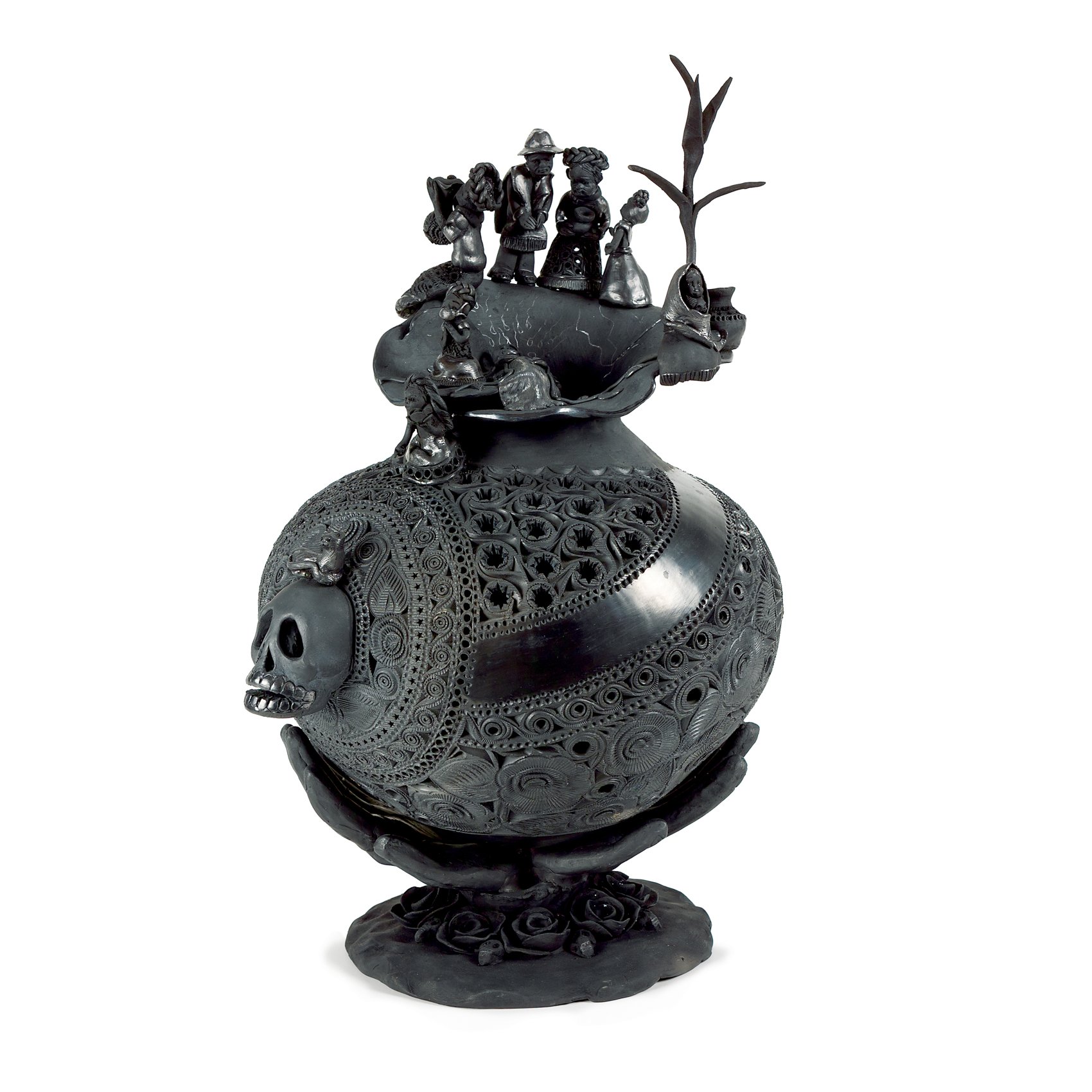The ArtisTS
SAN BARTOLO COYOTEPEC
The Pedro Martínez Family
This is an extraordinarily talented and productive clan of artists who create purely decorative pieces in the black pottery for which their pueblo is renowned. The family is distinguished by a remarkable diversity of individual styles. The parents, Antonio and Glafira, and their children and grandchildren, have each developed his or her own type of work. One of the offspring, Carlomagno, has achieved international fame for his outstanding interpretive pieces. Several other members have received significant acclaim, and their reputations are steadily growing.
Adelina Pedro Martínez (daughter of Antonio and Glafira)
Pueblo of San Bartolo Coyotepec
Zaragoza #3
adelina_barronegro@hotmail.com
(From US) Landline: 011-52-951-551-0175
Cell: 011-52-951-243-0856
(In Oaxaca) Landline: 551-0175
Cell: 951-243-0856
Adelina specializes in enchanting black ceramic angels and mermaids. Their distinctive faces are both cheerful and otherworldly. One of her favorite pieces is a large angel playing a mandolin. Her flowing matte and shiny skirt is punctuated by baby angels and carved flowers. Adelina has three daughters, all of whom work in ceramics when they are not pursuing their university studies, conserving the original style but also introducing something of their own.
Carlomagno Pedro Martínez (son of Antonio and Glafira)
Pueblo of San Bartolo Coyotepec
Guerrero #1
carlomagno2005@hotmail.com
(From US) Landline: 011-52-951-551-0034
Cell 011-52-951-171-1219
(In Oaxaca) Landline: 551-0034
Cell: 951-171-1219
Carlomagno Pedro Martínez is a powerful and innovative artistic force who creates unique sculptural forms and wall tableaux based on his interpretation of legends, stories and cultural beliefs. He has gained widespread international recognition for his distinctive assemblages of figures and objects treating a range of subjects. These include beliefs associated with the Day of the Dead (such as skeletons and devils); Mexican history (soldiers and other historical figures; and morality (for example, the devil responding to temptation as he observes a couple making love). Carlomagno’s figures range from nahuales (the mythical figures pictured as humans with animal faces) to witches, devils and muertos (skeletons in human activity). Some works are small, while others are large tableaux scenes, montages of ceramic forms mounted on large canvases, or major sculptural works of grand proportions.
Magdalena Pedro Martínez (daughter of Antonio and Glafira)
San Bartolo Coyotepec
Calle Morelos #42
regiones8@hotmail.com
(From US) Landline: 011-52-951-551-0266
Cell: 011-52-951-508-3021
(In Oaxaca) Landline: 551-0266
Cell: 951-508-3021
Magdalena is a both an outstanding ceramist and a medical doctor. She currently devotes more time to ceramics than to medicine, but has a small office in the pueblo. Magdalena specializes in female figures and mermaids dressed in the traditional costumes of the seven regions of the state of Oaxaca, viewing this as her particular contribution to the broader cause of preserving the culture of her ancestors. At present Magdalena has recorded 24 costumes in her ceramic masterpieces. She generally creates these figures in both sculptural and statuesque sizes, capturing the rich detail of costumes in a combination of shiny black and matte surfaces.
Antonio Eurípides Pedro González (grandson of Antonio and Glafira)
San Bartolo Coyotepec
Matamoros #17
rony1828@hotmail.com
(From US) Cell:
011-52-951-198-8857
(In Oaxaca) Cell: 951-198-8857
Antonio Eurípides is deeply devoted to the preservation of his cultural andspiritual traditions. His pieces reflect his religious beliefs, daily tasks like cooking, and traditional customs. Antonio enjoys creating assemblages of figures, such as processions in honor of the Virgin in which people carry religious objects, or a traditional cooking scene with women making tortillas and casseroles using carefully crafted miniature utensils. Like his aunt Magdalena, he also portrays female figures in their regional costumes, in some instances performing regional dances.
Alan Ocelotl Pedro González (grandson of Antonio and Glafira)
[Honorable mention in ceramics, FOFA’s 2008, 2011, 2013, 2016 contests]
San Bartolo Coyotepec
Zaragoza #2
alanpedrogonzalez@gmail.com
(From US) 011-52-951-107-1822
(In Oaxaca) Cell: 951-107-1822
Alan, a member of the distinguished Pedro ceramics family, has participated in all four of FOFA’s young artists’ competitions. He has loved working with clay above all other things in life since the age of five. Alan is determined to dedicate his life to art, believing that to mold clay is to enter another world. He experiences each piece as part dream and part imagination, evoking themes that represent his Zapotec heritage. This plumed serpent - watching over the treasure of Zapotec history - remains a common theme in his culture. “The plumed serpent is entwined with the tree of life that holds the spirits of our ancestors,” says Alan. “The child in its mouth represents the innocence that each of us carries within. Each apple represents the hope and life that inhabit our indigenous blood.”
Magaly Guadalupe Pedro González (granddaughter of Antonio and Glafira)
[Honorable mention, FOFA’s 2011 contest]
San Bartolo Coyotepec
Galeana #6
alfasire@yahoo.com
(From US) Cell:
011-52-951-162-6132
(In Oaxaca) Cell: 951-162-6132
Magaly, another member of the Pedro family of ceramicists, aspires to approximate the technique and quality of work produced by her grandfather. She also incorporates practices and customs that used to exist in her village of San Bartolo Coyotepec. This piece, which received honorable mention in FOFA’s 2011 young artists’ competition, is composed of two small figures doing the traditional “Dance of the Feather”; Magaly added a coyote on top, a reference to the many coyotes in San Bartolo Coyotepec that once inhabited the region, from which the town draws its name.
Fidel Martínez Martínez (cousin of Carlomagno, Adelina, Magdalena)
Pueblo of San Bartolo Coyotepec
Progreso #18
fidelmtzmtz@hotmail.com
(From US) Cell: 011-52-951-237-8703
(In Oaxaca) Cell: 951-237-8703
Fidel’s ceramic sculptures are extraordinary for their movement, passion and outstanding detail. In each unique piece he wishes to convey a message about the history and customs of his indigenous people. Some of his favorites are the daily labor of farmers carrying their produce in wagons pulled by oxen and musicians, as his wife and a number of their children play several instruments. Fidel’s talent has been recognized in many state and federal contests beginning in 1996, when he was invited to participate in a prestigious state competition. Fidel learned to work in clay beginning at five years of age from his mother who made traditional figures and whistles; he was the one of her nine children who most enjoyed this art. At times he has pieces for sale and at others it is necessary to commission his work.
Ayax Ollin Martínez Real (son of Fidel Martínez Martínez)
[3rd prize in Ceramics, FOFA’s 2018 contest]
Pueblo of San Bartolo Coyotepec
Progreso #18
ayaxollin@gmail.com
(From US) Cell: 011-52-951-447-8379
(In Oaxaca) Cell: 951-447-8379
Ayax is a law student who comes from a multi-talented family of ceramicists on his father’s side, and musicians on his mother’s side. He began creating small clay figures when he was three years old and still enjoys making intricate miniatures today. Set on a pyramid-shaped mountain, his piece includes engaging scenes that celebrate the joys and traditions of daily life. At the top, an artisan teaches his child to work in clay, while below an exciting fiesta with music and dance is in full swing. Ayax says, “I wanted to convey that clay is synonymous with our identity, and happiness is an important part of our culture.”
Abdiel Cardozo Calderón
[Honorable mention, FOFA’s 2013, 2016, 2018 contests]
Pueblo of San Bartolo Coyotepec
Independencia #37
abixmas_007@hotmail.com
(From US) Cell: 011-52-951-146-5844
(In Oaxaca) Cell: 951-146-5844
Abdiel learned to model black clay in diverse forms and sizes by studying with maestros Pedro Simón and Silvia Moreno. He wants all viewers to acquire knowledge of his Zapotec heritage. His ancient warrior is rich in cultural significance and symbolizes harmony with nature. The warrior is in the process of becoming a nahual, a title granted only to those who fully understood the origins of Zapotec culture and history. Once granted this status, the nahual may transform itself into a protective animal spirit. This Eagle Spirit is in the process of transformation, his right arm an eagle’s wing and the left still sprouting feathers. He gazes at the glass sphere held in his human hand and contemplates the wisdom that he struggles to acquire.
Ángel Carreño Hernández
[Honorable mention, FOFA’s 2013 contest]
Pueblo of San Bartolo Coyotepec
Zaragoza #10
carreno_hdz@hotmail.com
(From US) Cell: 011-52-951-134-0233
(In Oaxaca) 951-134-0233
Ángel typically works with his older brothers, carving designs on their black pots. He began working with his pueblo’s black clay when he was ten. Skilled with a knife, he is accustomed to working as part of a team, although he has always wanted to make figures. Now, for the first time, inspired by the contest and its theme, this work is his alone: a tree woman covered with precisely wrought butterflies. “The butterflies represent nature,” Ángel says. His proud, erect female, like Mother Earth, is a figure of abundant life. The artist wants us to see her relishing and admiring her creation.
The De Nieto Real Family
Pueblo of San Bartolo Coyotepec
Benito Juárez #24
dnojnca@prodigy.net.mx
(From US) Landline: 011-52-951-551-0011
(In Oaxaca) Landline: 551-0011
Doña Rosa was a giant in Oaxacan ceramics who died in 1980. She was renowned for her expertise in creating beautiful forms and for applying quartz to the clay before firing. This resulted in a brilliant and intense black surface, in contrast to the previously dull gray appearance of the utilitarian ceramics of this pueblo. A petite powerhouse of a woman, she sat on the ground on a petate (a woven straw mat) next to her “wheel,” two gray ceramic saucers placed back to back, a method pre-dating the Spanish conquest. The legacy of Doña Rosa was seen in the excellent ceramic work of her son, the late Don Valente, who in turn passed her techniques along to his wife, sons and daughters-in-law. Their debt to her is immediately apparent in the boldly displayed sign “Alfarería Doña Rosa” of their San Bartolo Coyotepec workshop. There on a grand patio surrounding a courtyard, the family creates and exhibits a vast range of decorative, reasonably priced pieces in traditional and contemporary styles. Each member of the family exhibits his or her work in one section of the large showroom.
The Fabián Canseco Family
Pueblo of San Bartolo Coyotepec
Hidalgo #2
(From US) Landline: 011-52-951-551-0313
Cell: 011-52-951-130-7850
(In Oaxaca) Landline: 551-0313
Cell: 951-130-7850
Miguel Fabián Pedro, his wife Esther Canseco Morga and their two children, Omar Fabián Canseco and Adelaida Fabián Canseco, create a wide variety of jugs and vases in black ceramics. Their styles range from purely traditional – primarily those of Miguel and Esther -- to extremely modern, the latter being the creations of Omar who was trained as a graphic designer but decided to return to his family’s ceramic crafts. Omar also creates tiles and other shapes for interior decoration, such as walls, murals, and ceilings. In their well-tended showroom, the visitor can see examples of jugs and other antiquities made many decades ago, as well as pieces in all styles produced by this active family.
The López González Family
Anakarem López González
[Honorable Mention in Ceramics, FOFA’s 2008, 2011, 2016, 2022 contests]
Morelos #24, San Bartolo Coyotepec 71294
(To call from US, first dial 011-52)
Tel celular • Cell phone: 951-569-9796
Email: oaxaquitalinda_2012@hotmail.com
Facebook: Karem Lopez
Instagram: @Karem Lopez
Anakarem was born into a world of clay. Her family’s one room home has simultaneously served as living room, dining room, kitchen and workshop. Having begun to create her own pieces at age seven, this deep black apaztle bowl is a perfect example of Anakarem’s skill in transforming the traditional into something new. A utilitarian form resting on a base for stability, the apaztle was used at times as a sink, a tub to bathe children, and a container in which to make tejate, a traditional Oaxacan beverage. Anakarem transformed this ancient form into a contemporary decorative piece by adding flowers and designs. She also produces beautifully shaped black ceramic jugs decorated with cut-out patterns.
Pamela Montserrat López González
[Honorable mention, FOFA’s 2016, 2018 contests]
Pueblo of San Bartolo Coyotepec
Morelos #24
esnom_sigloxxi@hotmail.com
(From US) Cell
011-52-951-569-9796
(In Oaxaca) Cell: 951-142-3579
As a member of a family working in black ceramics, Pamela feels fortunate to give form to the dreams and ideas that come to her through clay. She looks forward to sharing her passion for ceramics with her students in her teaching career. Pamela’s restless hands give life to clay figures like this endearing rooster born of childhood memories of being awakened early in the morning. This vessel (batidor) is an ancient form used to mix beverages like hot chocolate. Pamela has revived the traditional form in this decorative piece. She is delighted to receive recognition by others for her creative and playful talent, as when she won honorable mention in FOFA’s 2016 young artists’ competition.
Alfonso Martínez Méndez
[1st Place in Ceramics, FOFA’s 2022 Contest]
Calle Morelos #15, San Bartolo Coyotepec 71294
Cell phone: (From US) 011-52-951-270-3336 (In Oaxaca) 951-270-3336
Email: martinezméndezalfonso2@gmail.com
Facebook: Alfonso Martínez Méndez
Instagram: alf.mp88
Alfonso grew up as a painter in the Sierra Norte, traveling alone at 15 to the Central Valleys in search of another form of expression. He found employment where he passionately "connected" with clay, and began working independently in 2021. In his piece, hands support a pitcher expressing hopeful possibilities that arise from even the most serious world problems. A girl pointing to a dead figure finds hope in the new life that emerges from it. A small jar contains the dreams of another girl, conveying that hopes are individual. Another girl waits with her cat for crops to grow, expecting physical and spiritual nourishment.
Luis Manuel Ortíz Simon
[Honorable mention, FOFA’s 2013 contest]
Pueblo of San Bartolo Coyotepec
Reforma #11
orsiluma@hotmail.com
(From US) Cell: 011-52-951-551-0569
(In Oaxaca) Cell: 951-551-0569
Luis’ clay pot features a tree of life that sprouts leaves and then blooms into water, corn and light. One branch holds many different containers for water: the nigua, a flattened pot to store water or mezcal; a pitcher for fresh water; a tub for washing clothes; and a three-handled jug for carrying water. The other branch holds receptacles related to corn: a jug with perforations (pichancha) to wash and drain cooked corn; a bowl (apaxtle) for the corn masa (dough); and a pitcher for atole (a corn-based drink). Two candelabras in the center provide light and fire.
Floriberta Reyes Gómez & Andrés Cruz (miniatures)
Pueblo of San Bartolo Coyotepec
Independencia #2
(From US) Cell: 011-52-951-146-1155
011-52-951-349-2894
(In Oaxaca) Cell: 951-146-1155 and 951-349-2894
Floriberta and her husband Andrés create wonderful miniature jugs, pots, pitchers, vessels for making chocolate, flower pots and vases in black pottery, characterized by versatility and delicacy. Although the couple usually sells to fellow artisans in the local market, who in turn sell to the public, their home workshop is pleasant to visit, located in a heavenly spot adjacent to beautiful open fields at the end of a long, little traveled road. Floriberta learned to work in clay from her mother, who made utilitarian jugs. Andrés did not come from a ceramics family, but left his work as a farmer to join his wife in her specialty.
Ivett Guadalupe Simón Pacheco
[1st Place in Ceramics, FOFA’s 2022 Contest]
Privada de Aldama #3, Paraje el Tule,
San Bartolo Coyotepec 71294
Cell phone: (From US) 011-52-951-156-3726
(In Oaxaca) 951-156-3726
Email: ivettguadalupe17@gmail.com
Facebook: Tierra Lumbre Barro Negro
Instagram: tierra_lumbre
Ivett’s parents are ceramicists, as were her grandparents. Her university study of arts management and development has further enhanced her appreciation of the importance of folk art. When disturbing nighttime thoughts feel overwhelming and chaotic, the prospect of a new day offers reassurance; “the sun can help you heal.” Ivett’s interpretation of the 2022 contest theme was catalyzed by several appearances of beetles which made her think about a parallel between the cycle of day and night (represented by gold leaf), and the beetle’s cycle of reproduction: pushing a dung heap for food and burying it in the earth for breeding.
